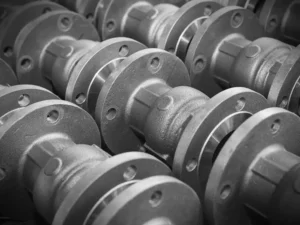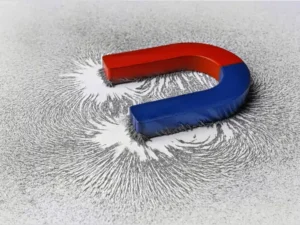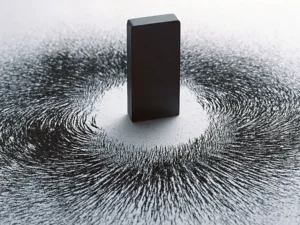L'acier inoxydable est-il magnétique ? Cette question a de nombreuses réponses, tout comme ce matériau a de nombreux types. Vous avez peut-être entendu dire que l'acier inoxydable est magnétique en raison de la présence de cuivre. C'est à la fois vrai et faux. Vous êtes confus ? Je suis sûr que vous l'êtes !
C'est pourquoi cette question appelle une réponse explicative. Selon son type, l'acier inoxydable présente un comportement à la fois magnétique et non magnétique. Deux facteurs principaux influencent son magnétisme. Commençons par comprendre ce matériau et son comportement magnétique.
Aperçu de l'acier inoxydable et du magnétisme

L'acier inoxydable n'est pas un élément unique mais un alliage de différents métaux. Il s'agit du chrome, du fer, du carbone, du nickel et du magnésium. La présence de chrome le rend inoxydable. La faible proportion de carbone suffit à le rendre dur. C'est l'un des métaux les plus utilisés en raison de sa capacité à lutter contre la rouille.
Il contient plus de 10,5% de chrome, ce qui le distingue. Certains types d'acier inoxydable contiennent une proportion de chrome encore plus élevée. Au contact de l'oxygène, le chrome forme une couche d'oxyde. Cette couche est utile car elle le protège de la rouille. Faisons un bref tour d'horizon du magnétisme.
Avez-vous déjà vu une pièce métallique coller à un aimant ? Ce phénomène est dû au magnétisme. Les principaux responsables sont le spin des électrons et la disposition des atomes dans le métal. Comme vous le savez, les électrons ont un spin. Les métaux ont de nombreux électrons qui tournent autour du noyau. Le spin des électrons individuels se combine et crée un magnétisme significatif.
Si la disposition des atomes ne favorise pas cette rotation, il n'y a pas de magnétisme. Les différents types d'acier inoxydable diffèrent les uns des autres. Ils présentent des arrangements d'atomes variés, tels que FFC, BCC, etc. Dans la section suivante, nous aborderons le comportement magnétique de ce matériau.
L'acier inoxydable est-il magnétique ?

Oui, et non ! Il existe différents types d'acier inoxydable. Chacun d'entre eux varie en termes de magnétisme. Par exemple, l'acier inoxydable ferritique et martensitique présente du magnétisme. En revanche, l'acier inoxydable austénitique ne présente aucun comportement magnétique. Cela est dû à leurs différences d'arrangement atomique.
Comme je l'ai dit précédemment, la disposition des atomes est essentielle pour le magnétisme. Chaque métal est constitué de nombreux atomes. Chaque atome est constitué d'électrons qui tournent autour du noyau. Chaque électron a son propre spin (qui produit un petit champ magnétique). Comme les atomes ont beaucoup d'électrons, leur spin collectif a un impact significatif.
Cette rotation collective d'un électron produit le magnétisme. Cependant, la disposition des atomes constitue un obstacle. Certains aciers inoxydables ont une structure d'atomes très organisée. Les atomes de ces types d'acier restent étroitement serrés les uns contre les autres. Ils ne supportent donc pas et n'annulent pas le spin collectif des électrons.
Par conséquent, il n'y a pas de magnétisme. L'acier inoxydable austénitique en est un exemple. À l'inverse, certains types d'acier inoxydable n'ont pas d'atomes de structure organisée. Ils restent vaguement maintenus ensemble. Ils supportent donc la rotation et ne modifient pas leur direction de rotation. Par conséquent, le spin des électrons produit du magnétisme.
L'acier inoxydable ferritique est un exemple de comportement magnétique. Rappelons que les atomes de métal sont disposés selon une géométrie spécifique appelée cristal. Ces cristaux déterminent si un métal est magnétique ou non magnétique. Un métal dont les atomes sont très organisés sera non magnétique, et vice versa.
Types d'acier inoxydable et leur magnétisme
Je ne vous laisserai pas vous contenter d'expliquer le magnétisme de l'acier inoxydable. Certains types d'acier inoxydable se comportent différemment à proximité d'un aimant. Voyons maintenant quels sont ces types d'acier et leurs caractéristiques magnétiques.
1- Acier inoxydable austénitique
Cet acier inoxydable est réputé pour sa résistance à la corrosion. Il contient une très grande quantité de chrome ainsi que d'autres éléments d'alliage. Il peut donc facilement produire de l'oxyde de chrome lorsqu'il est exposé à l'humidité, ce qui l'empêche de rouiller. En outre, il s'agit d'un acier inoxydable non magnétique. Mais la question est : pourquoi ?
Cette catégorie d'acier inoxydable présente des structures atomiques FCC (Face Centered Cubic). Les atomes sont étroitement liés et très bien organisés. Ils peuvent donc facilement annuler le spin ou le champ magnétique produit par leurs électrons. Par conséquent, il n'y a pas de magnétisme. Lorsqu'un tel alliage s'approche d'un aimant, il ne montre aucun mouvement. Les aciers inoxydables 304 et 316 en sont des exemples.
2- Acier inoxydable ferritique
Ce type d'acier inoxydable est peu coûteux. Il est moins résistant à la corrosion que l'acier austénitique. Ces métaux sont magnétiques et peuvent adhérer à des aimants proches. La raison en est qu'ils ont un cristal ou une disposition atomique BCC (Body Centered Cubic).
Dans ces métaux, les électrons tournent ou les petits champs magnétiques ne sont pas annulés. Les atomes sont mal fixés. Ainsi, le champ magnétique produit par la rotation des électrons réussit à s'aligner. Par conséquent, ce métal devient magnétique. Il adhère à l'aimant. Les aciers inoxydables de qualité 430 et 409 en sont des exemples.
3- Acier inoxydable martensitique
Ce métal a une forte teneur en carbone, ainsi qu'en fer, en chrome et en nickel. C'est pourquoi il est très dur. Toutefois, contrairement à l'acier inoxydable austénitique, il est magnétique. Ses propriétés sont similaires à celles du magnétisme. Il est intéressant de noter que son arrangement atomique est similaire à celui de l'acier inoxydable ferritique.
Vous vous demandez peut-être s'ils appartiennent à la catégorie des aciers inoxydables ferritiques. Mais ce n'est pas le cas, car ils ont leur propre catégorie. Lors d'un refroidissement instantané, leur arrangement électronique est perturbé. Ainsi, leur cristal passe de BCC à BCT, c'est-à-dire un cristal trigonal centré sur le corps. La disposition des atomes n'annule pas le spin collectif des électrons.
En conséquence, le spin de ces électrons s'aligne et crée un champ magnétique important. Le métal devient donc magnétique. La question est de savoir comment ils sont refroidis pour changer de structure. Ces aciers inoxydables sont durs et subissent un échauffement. Lors du chauffage, les fabricant d'acier les refroidit immédiatement. Par conséquent, leurs structures sont perturbées.
Point supplémentaire : Ce refroidissement soudain au cours du processus thermique est appelé trempe. Cette transformation d'une très haute température à une basse température est critique. Elle provoque des désordres dans la structure de ces métaux. Les métaux 410 et 420 en sont des exemples.
4- Acier inoxydable duplex
Il s'agit d'un type unique d'acier inoxydable dont la structure atomique est différente. Ses caractéristiques sont un mélange d'aciers inoxydables austénitiques et ferritiques. La raison en est que sa microstructure atomique présente à la fois des arrangements cristallins FCC et BCC. Certains atomes sont centrés dans un arrangement cubique. Cette phase empêche les propriétés magnétiques de ces métaux.
Cependant, certaines de leurs parties atomiques ont des arrangements ou des structures cubiques centrées sur le corps. Ainsi, cette partie, comme le métal ferrite, favorise le comportement magnétique. Le spin des électrons peut s'aligner, ce qui confère au métal sa nature magnétique. Ces types d'acier inoxydable sont obtenus par le processus de chauffage.
Pensez-vous à leurs propriétés mécaniques ? Elles sont similaires à celles des aciers inoxydables austénitiques et ferritiques. Ils sont solides, résistants à la corrosion et à la fatigue. Surtout, leur prix n'est pas trop élevé, ce qui est un grand avantage. Le fabricant produit ces métaux pour répondre aux exigences particulières de ses projets. Il s'agit par exemple des nuances 2205 et 2507.
5- Acier inoxydable durci par précipitation
Ces aciers inoxydables sont similaires aux types martensitiques. Il y a un aspect essentiel à comprendre. Ces aciers sont produits par chauffage puis par refroidissement. Leurs microstructures passent donc de BCC à BCT sous l'effet du chauffage et du refroidissement. Le passage de BBC à BCT est similaire à celui de l'acier inoxydable martensitique. En ce qui concerne leur magnétisme, ils sont magnétiques. Lorsqu'ils sont placés près d'un aimant, ils présentent un certain mouvement d'attraction.
Pourquoi le magnétisme est-il important dans l'acier inoxydable ?

Le comportement magnétique de l'acier inoxydable est utile à bien des égards. Tout d'abord, cette propriété est excellente pour identifier les différents matériaux. Vous pouvez identifier les différents types d'acier inoxydable à l'aide d'un aimant. Pour ce faire, vous placerez un aimant à proximité de la pièce. Si elle est attirée par l'aimant, il s'agit d'un acier inoxydable ferritique ou martensitique.
N'oubliez pas que chaque acier inoxydable a ses propres propriétés. Par exemple, l'acier inoxydable austénitique a une teneur élevée en chrome et est inoxydable. En revanche, l'antirouille de l'acier inoxydable ferritique est légèrement compromis. Les fabricants utilisent une caractéristique magnétique pour évaluer l'acier inoxydable. Cela les aide à comprendre ses caractéristiques et ses types.
En fin de compte, les fabricants choisissent le matériau approprié pour les produits. De plus, certaines applications font appel au comportement magnétique de l'acier inoxydable. Par exemple, les composants des capteurs et des systèmes électriques utilisent l'acier inoxydable. Ces produits utilisent le comportement magnétique de ce métal. Le magnétisme joue donc un rôle crucial dans l'application et l'utilisation de ce matériau.
Facteurs affectant le magnétisme de l'acier inoxydable
La nature magnétique de l'acier inoxydable est, d'une manière ou d'une autre, liée à de nombreux autres facteurs. Ces facettes peuvent affecter les propriétés magnétiques de tous les types d'acier. Voici la liste des principaux facteurs qui affectent le magnétisme de l'acier inoxydable :
- Composition
- Soudage et fabrication
- Processus de chauffage et de refroidissement
- Arrangement atomique (microstructure)
- La présence d'électrons non appariés dans l'orbitale
Si l'acier inoxydable a une teneur élevée en nickel, il sera non magnétique. De même, le chauffage et le refroidissement soudain peuvent également modifier les propriétés magnétiques. L'arrangement atomique et la rotation des électrons sont les facteurs les plus fondamentaux. Un métal dont la structure des atomes est organisée sera non magnétique, et vice versa.
Questions fréquemment posées
Les aimants adhèrent-ils à l'acier inoxydable ?
Cela dépend du type d'acier inoxydable. Les aimants n'adhèrent pas à certains types d'acier inoxydable, comme l'acier austénitique. En revanche, les aciers ferritiques et martensitiques adhèrent aux aimants. Ces types d'acier sont magnétiques en raison de l'empilement lâche des électrons.
Quel est l'acier inoxydable le plus magnétique ?
L'acier inoxydable ferritique est considéré comme le plus magnétique en raison de ses atomes centrés. En outre, la perte de l'agencement des atomes renforce encore leur magnétisme. Les aciers inoxydables de qualité 430 et 409 en sont des exemples.
Comment identifier l'acier inoxydable à la maison ?
Il est facile d'identifier l'acier inoxydable. Il suffit d'approcher un aimant de la pièce métallique. Si la pièce se rapproche de l'aimant et y adhère, il s'agit d'un acier inoxydable ferritique ou martensitique. Si elle ne colle pas, il s'agit d'un acier inoxydable austénitique.
Conclusion
L'acier inoxydable est un matériau bien connu des industries manufacturières. Il se distingue par son excellente protection contre la rouille et sa résistance. Cependant, son comportement face aux aimants semble déconcerter les gens. Il n'y a pas d'erreur de leur part ; au contraire, l'acier inoxydable a plusieurs comportements.
Il existe différents types d'acier inoxydable, et chacun se comporte différemment. Par exemple, l'acier inoxydable austénitique n'est pas magnétique, alors que l'acier ferritique l'est. Tous ces types d'acier ont en commun la résistance à la corrosion et la solidité. Ce guide couvre tous les aspects de l'acier inoxydable.
